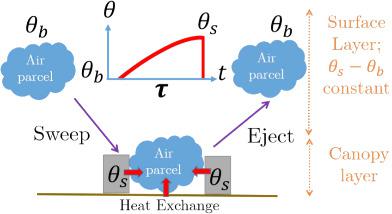当前位置:
X-MOL 学术
›
Q. J. R. Meteorol. Soc.
›
论文详情
Our official English website, www.x-mol.net, welcomes your feedback! (Note: you will need to create a separate account there.)
Revisiting the relation between momentum and scalar roughness lengths of urban surfaces
Quarterly Journal of the Royal Meteorological Society ( IF 8.9 ) Pub Date : 2020-06-07 , DOI: 10.1002/qj.3839 Qi Li 1, 2 , Elie Bou‐Zeid 2 , Sue Grimmond 3 , Sergej Zilitinkevich 4 , Gabriel Katul 2, 5, 6
Quarterly Journal of the Royal Meteorological Society ( IF 8.9 ) Pub Date : 2020-06-07 , DOI: 10.1002/qj.3839 Qi Li 1, 2 , Elie Bou‐Zeid 2 , Sue Grimmond 3 , Sergej Zilitinkevich 4 , Gabriel Katul 2, 5, 6
Affiliation

|
Large‐Eddy Simulations (LESs) of neutral flow over regular arrays of cuboids are conducted to explore connections between momentum (z0m) and scalar (z0s) roughness lengths in urban environments, and how they are influenced by surface geometry. As LES resolves the obstacles but not the micro‐scale boundary layers attached to them, the aforementioned roughness lengths are analyzed at two distinct spatial scales. At the micro‐scale (roughness of individual facets, e.g., roofs), it is assumed that both momentum and scalar transfer are governed by accepted arguments for smooth walls that form the basis for the LES wall‐model. At the macro‐scale, the roughness lengths are representative of the aggregate effects of momentum and scalar transfer over the resolved roughness elements of the whole surface, and hence they are directly computed from the LES. The results indicate that morphologically based parametrizations for macro‐scale z0m are adequate overall. The relation between the momentum and scalar macro‐roughness values, as conventionally represented by  and assumed to scale with
and assumed to scale with  (where Re∗ is a roughness Reynolds number), is then interpreted using surface renewal theory (SRT). SRT predicts n = 1/4 when only Kolmogorov‐scale eddies dominate the scalar exchange, whereas n = 1/2 is predicted when large eddies limit the renewal dynamics. The latter is found to better capture the LES results. However, both scaling relations indicate that z0s decreases when z0m increases for typical urban geometries and scales. This is opposite to how their relation is usually modelled for urban canopies (i.e., z0s/z0m is a fixed value smaller than unity).
(where Re∗ is a roughness Reynolds number), is then interpreted using surface renewal theory (SRT). SRT predicts n = 1/4 when only Kolmogorov‐scale eddies dominate the scalar exchange, whereas n = 1/2 is predicted when large eddies limit the renewal dynamics. The latter is found to better capture the LES results. However, both scaling relations indicate that z0s decreases when z0m increases for typical urban geometries and scales. This is opposite to how their relation is usually modelled for urban canopies (i.e., z0s/z0m is a fixed value smaller than unity).
中文翻译:

回顾动量与城市表面标量粗糙度长度之间的关系
进行长方体常规阵列上的中性流动的大涡模拟(LESs),以探索动量(z 0 m)和标量(z 0 s)之间的联系)城市环境中的粗糙度长度,以及它们如何受到表面几何形状的影响。当LES解决了障碍但没有解决附着在障碍物上的微尺度边界层时,上述粗糙度长度将在两个不同的空间尺度上进行分析。在微观尺度(各个面的粗糙度,例如屋顶)上,假设动量和标量传递均受构成LES壁模型基础的光滑壁的公认论据支配。在宏观尺度上,粗糙度长度代表了动量和标量传递对整个表面的解析粗糙度元素的总体影响,因此可以直接从LES中计算得出。结果表明,宏观尺度z 0 m的基于形态学的参数化总体而言足够。然后,使用表面更新理论(SRT)来解释动量和标量宏观粗糙度值之间的关系,该关系通常 用来表示并假定与之成比例
用来表示并假定与之成比例 (其中Re ∗是粗糙度雷诺数)。当仅Kolmogorov规模的旋涡主导标量交换时,SRT预测n = 1/4,而当大旋涡限制更新动力学时,则预测n = 1/2。发现后者可以更好地捕获LES结果。但是,这两个比例关系表明,Z ^ 0小号减小,当Z ^ 0中号对于典型的城市几何形状和规模会有所增加。这与通常为城市雨棚建模的关系相反(即z 0 s / z 0 m为小于1的固定值)。
(其中Re ∗是粗糙度雷诺数)。当仅Kolmogorov规模的旋涡主导标量交换时,SRT预测n = 1/4,而当大旋涡限制更新动力学时,则预测n = 1/2。发现后者可以更好地捕获LES结果。但是,这两个比例关系表明,Z ^ 0小号减小,当Z ^ 0中号对于典型的城市几何形状和规模会有所增加。这与通常为城市雨棚建模的关系相反(即z 0 s / z 0 m为小于1的固定值)。
更新日期:2020-06-07
 and assumed to scale with
and assumed to scale with  (where Re∗ is a roughness Reynolds number), is then interpreted using surface renewal theory (SRT). SRT predicts n = 1/4 when only Kolmogorov‐scale eddies dominate the scalar exchange, whereas n = 1/2 is predicted when large eddies limit the renewal dynamics. The latter is found to better capture the LES results. However, both scaling relations indicate that z0s decreases when z0m increases for typical urban geometries and scales. This is opposite to how their relation is usually modelled for urban canopies (i.e., z0s/z0m is a fixed value smaller than unity).
(where Re∗ is a roughness Reynolds number), is then interpreted using surface renewal theory (SRT). SRT predicts n = 1/4 when only Kolmogorov‐scale eddies dominate the scalar exchange, whereas n = 1/2 is predicted when large eddies limit the renewal dynamics. The latter is found to better capture the LES results. However, both scaling relations indicate that z0s decreases when z0m increases for typical urban geometries and scales. This is opposite to how their relation is usually modelled for urban canopies (i.e., z0s/z0m is a fixed value smaller than unity).
中文翻译:

回顾动量与城市表面标量粗糙度长度之间的关系
进行长方体常规阵列上的中性流动的大涡模拟(LESs),以探索动量(z 0 m)和标量(z 0 s)之间的联系)城市环境中的粗糙度长度,以及它们如何受到表面几何形状的影响。当LES解决了障碍但没有解决附着在障碍物上的微尺度边界层时,上述粗糙度长度将在两个不同的空间尺度上进行分析。在微观尺度(各个面的粗糙度,例如屋顶)上,假设动量和标量传递均受构成LES壁模型基础的光滑壁的公认论据支配。在宏观尺度上,粗糙度长度代表了动量和标量传递对整个表面的解析粗糙度元素的总体影响,因此可以直接从LES中计算得出。结果表明,宏观尺度z 0 m的基于形态学的参数化总体而言足够。然后,使用表面更新理论(SRT)来解释动量和标量宏观粗糙度值之间的关系,该关系通常
 用来表示并假定与之成比例
用来表示并假定与之成比例 (其中Re ∗是粗糙度雷诺数)。当仅Kolmogorov规模的旋涡主导标量交换时,SRT预测n = 1/4,而当大旋涡限制更新动力学时,则预测n = 1/2。发现后者可以更好地捕获LES结果。但是,这两个比例关系表明,Z ^ 0小号减小,当Z ^ 0中号对于典型的城市几何形状和规模会有所增加。这与通常为城市雨棚建模的关系相反(即z 0 s / z 0 m为小于1的固定值)。
(其中Re ∗是粗糙度雷诺数)。当仅Kolmogorov规模的旋涡主导标量交换时,SRT预测n = 1/4,而当大旋涡限制更新动力学时,则预测n = 1/2。发现后者可以更好地捕获LES结果。但是,这两个比例关系表明,Z ^ 0小号减小,当Z ^ 0中号对于典型的城市几何形状和规模会有所增加。这与通常为城市雨棚建模的关系相反(即z 0 s / z 0 m为小于1的固定值)。



























 京公网安备 11010802027423号
京公网安备 11010802027423号